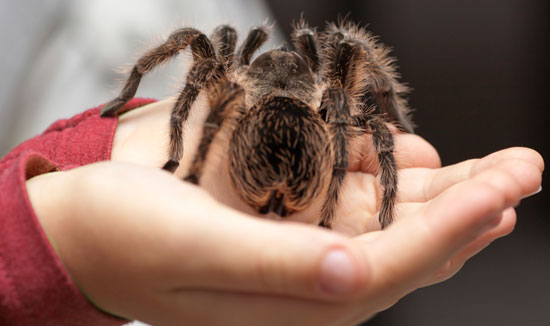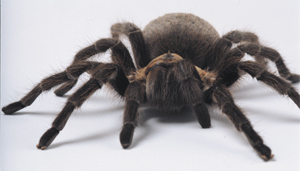How to Keep Spiders as Pets
Spiders can make fascinating pets. Here are a few steps to get you started keeping spiders.

Step 1: Catch a spider
Spiders are all around us, indoors and out, so they’re not hard to find. Some species can bite and a few are venomous. Learn about dangerous spiders in your area before heading out. It’s easy to safely catch a spider by using a small jar. Gently coax it into the jar using the lid. Spiders will eat each other, so keep only one per jar.
Step 2: Prepare a cage
Large spiders do well in the inexpensive plastic terrariums available from pet stores. Smaller ones can be kept in jars or plastic containers if air holes are drilled into the lid or sides. Be sure the holes are small enough to prevent escape.
Potting soil makes good cover for the cage bottom. Sticks, dead leaves or artificial plants provide structure for hiding, climbing and webbing.
Step 3: Water
Depending on the size of the spider, anything from a plastic bottle cap to a small bowl can serve as a water dish. Spiders also drink water sprayed on webbing, but you should never allow the cage to become damp.
Step 4: Feeding
Offer insect prey once or twice a week. Crickets are available from pet shops, or you can collect insects outdoors if no insecticides have been sprayed in the area.
Step 5: Observing
Watch your spider and take notes on its behavior. You won’t believe what happens in the spider’s web until you’ve visited it yourself!
PREFERRED PETS
 Not all spiders do well in captivity. Active hunters are usually easier to keep than web builders. Here are a few that make good pets.
Not all spiders do well in captivity. Active hunters are usually easier to keep than web builders. Here are a few that make good pets.
Tarantulas: Some species exceed 10 inches in legspan. They’re by far the most popular pet spiders and can be bought in pet stores.
Wolf Spiders: Some can be more than three inches in legspan. Large specimens do best in terrariums with lots of floor space.
Jumping Spiders: Although small and rarely exceeding half an inch, their jumping ability is amazing. Many species are brightly colored and can easily be kept in jars.
Fishing Spiders: In captivity, these large spiders appreciate vertically arranged pieces of bark for climbing. They’re very fast, so use caution when capturing them.
Grass Spiders: These spiders build funnel-shaped webs in grass, bushes and on buildings. In captivity, they will build extensive webs inside their cage.
LEARN MORE: Click here to see photos of a spider expert’s seven favorite spiders
I’m a girl and I like this website
I have got a common jumping spider that is dead leaf tone brown color and I do exactly same the instructions than I went get some dead leaves and give her food then she just gone in the leaves!Oh I give her another spider but not a same kind as her and it just gone now!
Jumping spiders are carnivorous, which means that they would easily prey on other spiders for lunch.
I am a girl, and I want a pet spider. Does that make me weird?
No, you are not special.
No
I captured a Black lace weaver and is now in a small terranium, siutable for her size. and she is doing amazing,she is lazy and after 2 weeks realised its easier to build her web directly under the feeding area.lol. but big bertha is truly happy. and fat. xxx
No!! im a girl and i love spiders! my dads name is spider, so i think in weirder! lol xx
no. stop trying to be quirky and special
Do people keep writing spiders? I think they are so gorgeous. am I weird for thinking that? I just love their bright colors and the patterns in their webs.
do people keep writing spiders? I think they are so gorgeous. am I weird for thinking that? I just love their bright colors and the patterns in their webs.
I’m keeping a small house spider that I found in my house but I don’t know what species it is and what it eats ??
Do spiders heart people and why do people have them for a pet
mabye try feeding mosquitos or flies that are already dead?
Rip money spider and fishing spider p.s good luck with that wolf spider
I’m keeping several species of spider at the moment. Most of them are arboreol, any good enclosures for species like those?
I caught a stocky spider with a reddish – brown front and a grey abdomen . She is starting to Web – build around her enclosure but she won’t eat . what do I do?
It sounds as though you have Dysdera Crocata – the woodlouse spider. Eats woodlice or pillgugs.
id say shes one of the wolf spider variety, try very small crickets, you can get them from pets at home, its what i feed my black lace weaver, they are the same size and eat the same things
I caught a grass spider and i put dirt and other stuff in there and the spider keeps trying to escape
What do i do? And i have everything it needs. And every week i feed it woodlouse
try a variety of different insects until it eats or maybe its sick or gonna lay eggs so if its not eating id sugest releasing it
I have a grass spider and it keeps trying to escape
What do i do?